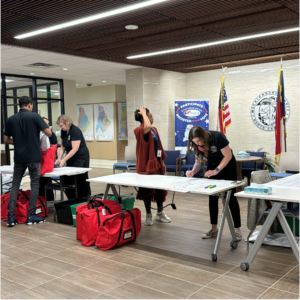16 year-old Klara Hammudeh reports on the logistics behind voting in the US elections

November 5, 2025. Votes counting in Mecklenburg County Board of Elections, Charlotte, North Carolina.
November 8, 2024
America votes! A cliffhanger night at the vote count in Mecklenburg County, North Carolina
Just before 7pm on election day, November 5, the Harbingers’ Magazine team arrived at Myers Park Traditional Elementary School in Charlotte, North Carolina. This is where one of Mecklenburg County’s polling stations − specifically, Precinct 102 – was located.
Although we were not allowed to film the voting process, the precinct judge told us that the place was very busy throughout the day and that more than 80% of voters registered there had already cast their ballots.
Voting is just one step in an elaborate logistical effort. Before the polling stations open, the behind-the-scenes preparations last months, but the most challenging part happens once the doors to precincts have closed − and Harbingers’ Magazine saw the vote count up close.
Every registered voter receives a ballot, on which they mark who they would like to become the president of the United States (North Carolina, as in many other states, a number of other federal and state level officials were also elected on November 5).
Given that Donald Trump repeated unsubstantiated warnings that the election might be rigged, it was up to the election officials to provide the results fast, and without giving anyone an opportunity to challenge the numbers.
America votes! Polls open after Harris and Trump make last push for Pennsylvania
In North Carolina, votes are read by machines (called tabulators) that scan the ballots and transcribe them onto paper and USB drives. Security measures are strict: the tabulators are tested, locked, sealed with tamper-evident seals, and stored in a locked room until they are used for voting.
Accordingto the North Carolina State Board of Elections, the machines also require “a unique physical equipment key to turn the equipment on and to access any media port on the equipment. Only authorized individuals may have keys and security codes to open voting machines.”
Additionally, voting equipment is not allowed to be connected to the internet so that there is less risk of interference – in fact, voting machines contain no modems, so it is impossible to connect them online.
When we arrived at the offices of Mecklenburg County Board of Elections, we met dozens of excited people. Results from all of the county’s 195 precincts are brought here to be counted, so there were also several police cars to protect the fairness of the count.

November 5, Charlotte, North Carolina. Bags stack up during the vote count at Mecklemburg County.
The first people I saw were volunteers in hi-vis vests standing next to large black bins on wheels. The ballots – packed in red and blue bags – arrive from precincts, and are taken into the main building in wheeled bins.
Blue and red in this case are not not votes for Republicans and Democrats – the blue bags contained provisional ballots (for voters whose eligibility may be in question), which were brought upstairs for verification, while the red bags held tabulator results, which went downstairs for counting.
There was also a crew of runners taking the provisional ballots upstairs. It was a very long and complicated, but (also carefully thought-through) process.
Kristin Mavromatis, the Public Information Manager for the Mecklenburg County Board of Elections, who oversaw the count, reacted immediately when we set up our camera inside the building. “I can’t have you here. From here to there” – Ms Mavromatis pointed at a door to the back of the building – “is where my results are going in. You can’t be where you are right now.”
She instructed all all media to set up their cameras outside the main hall.“We’re completely paper… very antiquated,” she said, explaining why she could not provide an estimate of how many votes were going to be counted at her office.
Trump wins second term as US president
The first car arrived, to much excitement. The process gradually transformed into a steady stream of runners, who pushed carts, separated the bags and carried them up the stairs and into the building, where a pile of bags mounted in the hall.
Finally, at 10.18pm, we and the other media outlets received the first results for the county, which covered votes from early voting and some from election day. At that point, Kamala Harris had a strong lead in the county with 349,588 votes, compared to 175,444 for Donald Trump.
Mecklenburg Countymay have voted Democrat, but most of North Carolina was of a different opinion – a few hours later, it was clear that Donald Trump had won North Carolina and its 16 electoral votes.
North Carolina was the first swing state called, and a big step for Trump towards the White House; later, it turned out that Trump had won all seven swing states and was on his way to become the 47th president of the United States.



